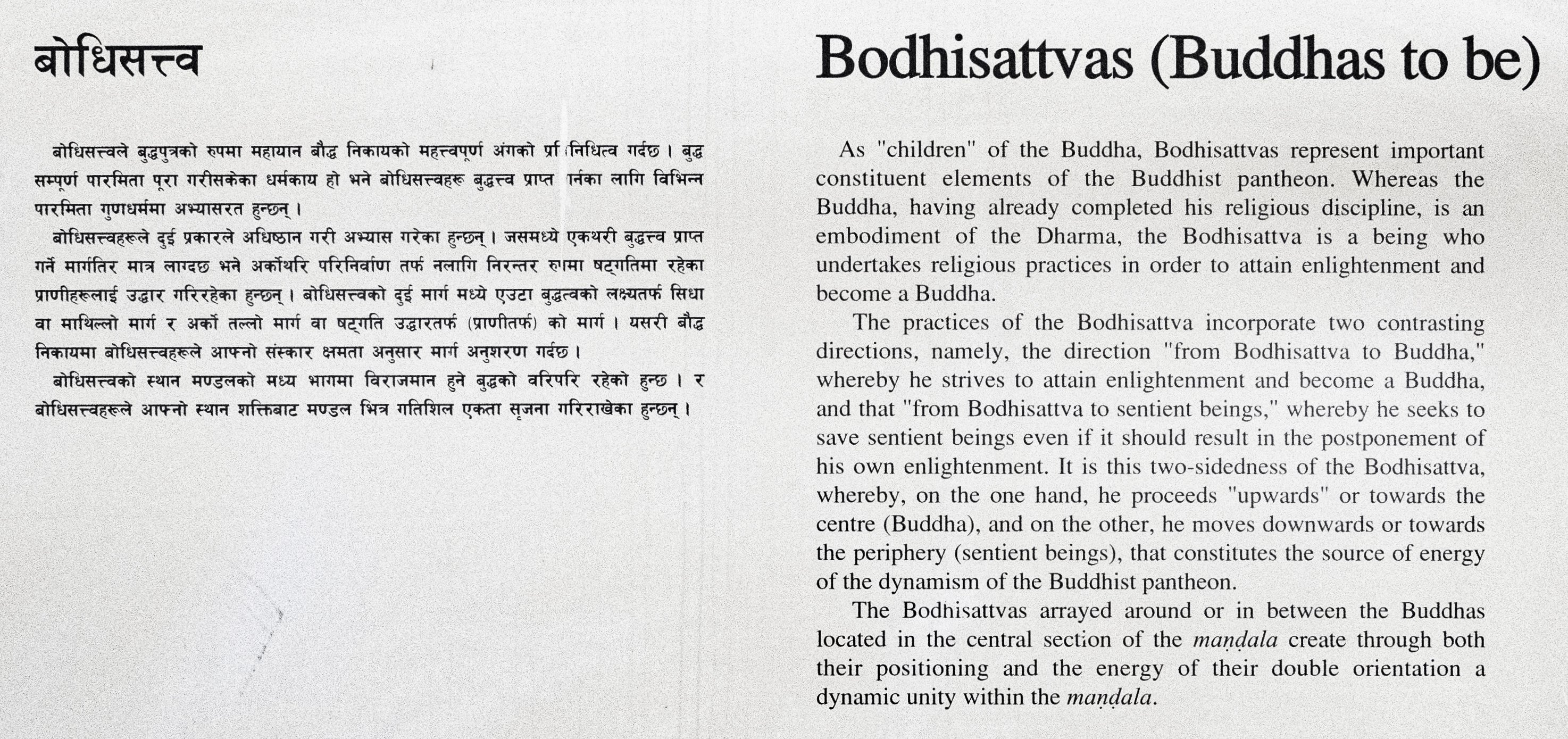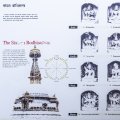Buddhist Art Gallery: Northern Himalayan Section: photo 109
Photo 109 of 198 in Gallery: Buddhist Art Gallery: Northern Himalayan Section

Image title: Bodhisattvas (Buddhas to be)
Description of the photo
English text:
As "children" of the Buddha, Bodhisattvas represent important constituent elements of the Buddhist pantheon. Whereas the Buddha, having already completed his religious discipline, is an embodiment of the Dharma, the Bodhisattva is a being who undertakes religious practices in order to attain enlightenment and become a Buddha.
The practices of the Bodhisattva incorporate two contrasting directions, namely, the direction "from Bodhisattva to Buddha," whereby he strives to attain enlightenment and become a Buddha, and that "from Bodhisattva to sentient beings," whereby he seeks to save sentient beings even if it should result in the postponement of his own enlightenment. It is this two-sidedness of the Bodhisattva, whereby, on the one hand, he proceeds "upwards" or towards the centre (Buddha), and on the other, he moves downwards or towards the periphery (sentient beings), that constitutes the source of energy of the dynamism of the Buddhist pantheon.
The Bodhisattvas arrayed around or in between the Buddhas located in the central section of the mandala create through both their positioning and the energy of their double orientation a dynamic unity within the mandala.
Nepalese text (not proofread)
बोधिसत्त्व—बोधिसत्त्वले बुद्धपुत्रको रुपमा महायान बौद्ध निकायको महत्त्वपूर्ण अंगको प्रनिधित्व गर्दछ । बुद्ध सम्पूर्ण पारमिता पूरा गरीसकेका धर्मकाय हो भने बोधिसत्त्वहरू बुद्धत्त्व प्राप्त गर्नका लागि विभिन्न पारमिता गुणधर्ममा अभ्यासरत हुन्छन् ।
बोधिसत्त्वहरूले दुई प्रकारले अधिष्ठान गरी अभ्यास गरेका हुन्छन् । जसमध्ये एकथरी बुद्धत्त्व प्राप्त गर्ने मार्गतिर मात्र लाग्दछ भने अर्कोथरि परिनिर्वाण तर्फ नलागि निरन्तर रुपमा षट्गतिमा रहेका प्राणीहरूलाई उद्धार गरिरहेका हुन्छन् । बोधिसत्त्वको दुई मार्ग मध्ये एउटा बुद्धत्वको लक्ष्यतर्फ सिधा वा माथिल्लो मार्ग र अर्को तल्लो मार्ग वा षट्गति उद्धारतर्फ (प्राणीतर्फ) को मार्ग । यसरी बौद्ध निकायमा बोधिसत्त्वहरूले आफ्नो संस्कार क्षमता अनुसार मार्ग अनुशरण गर्दछ ।
बोधिसत्त्वको स्थान मण्डलको मध्य भागमा विराजमान हुने बुद्धको वरिपरि रहेको हुन्छ । र बोधिसत्त्वहरूले आफ्नो स्थान शक्तिबाट मण्डल भित्र गतिशिल एकता सृजना गरिराखेका हुन्छन् ।
Nepalese to English (automated translation)
Bodhisattva—The Bodhisattva represents an important part of the Mahayana Buddhist body as the son of the Buddha. Buddha is a dharmakaya who has completed all paramita, while bodhisattvas practice various paramita qualities to attain Buddhahood.
Bodhisattvas practiced in two ways. One of them only goes towards the path of attaining enlightenment, while the other one does not go towards parinirvana, but they are constantly rescuing beings who are in shatgatati. Of the two paths of the bodhisattva, one is the direct or upper path to the goal of enlightenment, and the other is the lower path or the path to salvation (towards beings). In this way, the bodhisattvas in the Buddhist body follow the path according to their rites ability.
The Bodhisattva's position is around the Buddha seated in the center of the mandala. And the Bodhisattvas create a dynamic unity within the mandala through their positional power.
Transcription (with diacritics):
Bodhisattva—bodhisattvale buddhaputrako rupamā mahāyāna bauddha nikāyako mahattvapūrṇa aṃgako pranidhitva gardacha . Buddha sampūrṇa pāramitā pūrā garīsakekā dharmakāya ho bhane bodhisattvaharū buddhattva prāpta garnakā lāgi vibhinna pāramitā guṇadharmamā abhyāsarata hunchan .
bodhisattvaharūle duī prakārale adhiṣṭhāna garī abhyāsa garekā hunchan . Jasamadhye ekatharī buddhattva prāpta garne mārgatira mātra lāgdacha bhane arkothari parinirvāṇa tarpha nalāgi nirantara rupamā ṣaṭgatimā rahekā prāṇīharūlāī uddhāra garirahekā hunchan . Bodhisattvako duī mārga madhye euṭā buddhatvako lakṣyatarpha sidhā vā māthillo mārga ra arko tallo mārga vā ṣaṭgati uddhāratarpha (prāṇītarpha) ko mārga . Yasarī bauddha nikāyamā bodhisattvaharūle āphno saṃskāra kṣamatā anusāra mārga anuśaraṇa gardacha .
bodhisattvako sthāna maṇḍalako madhya bhāgamā virājamāna hune buddhako varipari raheko huncha . Ra bodhisattvaharūle āphno sthāna śaktibāṭa maṇḍala bhitra gatiśila ekatā sṛjanā garirākhekā hunchan .
Transcription (without diacritics):
bodhisattva—bodhisattvale buddhaputrako rupama mahayana bauddha nikayako mahattvapurna amgako pranidhitva gardacha . buddha sampurna paramita pura garisakeka dharmakaya ho bhane bodhisattvaharu buddhattva prapta garnaka lagi vibhinna paramita gunadharmama abhyasarata hunchan .
bodhisattvaharule dui prakarale adhishthana gari abhyasa gareka hunchan . jasamadhye ekathari buddhattva prapta garne margatira matra lagdacha bhane arkothari parinirvana tarpha nalagi nirantara rupama shatgatima raheka praniharulai uddhara gariraheka hunchan . bodhisattvako dui marga madhye euta buddhatvako lakshyatarpha sidha va mathillo marga ra arko tallo marga va shatgati uddharatarpha (pranitarpha) ko marga . yasari bauddha nikayama bodhisattvaharule aphno samskara kshamata anusara marga anusharana gardacha .
bodhisattvako sthana mandalako madhya bhagama virajamana hune buddhako varipari raheko huncha . ra bodhisattvaharule aphno sthana shaktibata mandala bhitra gatishila ekata srijana garirakheka hunchan .
Gallery information:
The Northern Himalayan region in Nepal offers a wide variety of Buddhist objects such as paintings, scriptures, sculptures, ritualistic objects, etc. Buddhism once entered Tibet from Nepal and has blended in its own way there, resulting in Tibetan Buddhism which is divided into many schools. The items found here are exhibited in the National Museum of Nepal (Rashtriya Museum).
Photo details:
Date: 2019-12-04
Camera: SONY ILCE-6400
Exposure: 1/160
Aperture: f/3.5
ISO: 3200
Focal length: 18mm
High resolution:
Download file
Size: 2.95 MB
Resolution: 2948 x 1389
© Photograph by Gabe Hiemstra.
License: CC BY-NC-ND 4.0

